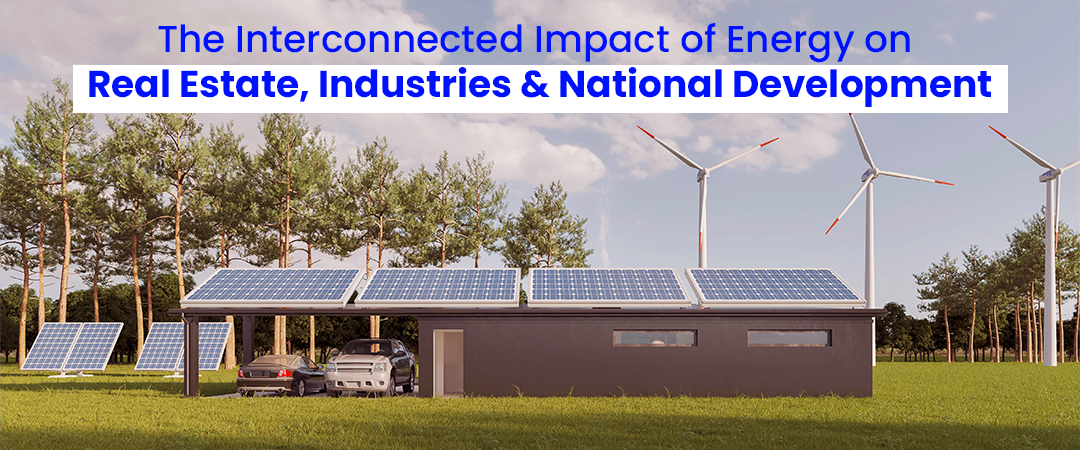


Energy is the lifeblood of our societies, powering our homes, industries as well as our transportation systems. That being said, the way we generate and consume energy has a profound impact that goes far beyond just utility bills. For decades, location, size, and amenities have been the cornerstones of real estate valuation. Today, energy efficiency and sustainability are rapidly becoming equally important factors. Due diligence on Energy monitoring and management will result in cost savings through decreased usage and consumption and can also result in reduced reliance on our sometimes volatile, traditional supply chains. This realization has spurred a paradigm shift in the industry.
When it comes to Real Estate, the places we live and work are undergoing a transformation inherently driven by energy considerations. In the residential sector, energy-efficient homes are becoming increasingly desirable. Smart homes with inbuilt systems that optimize heating, cooling, and lighting or even having the capacity to generate their own power through rooftop solar panels translates to lower energy bills for homeowners and also reduces the strain on the national grid and helps create a cleaner future.
This is true for commercial and industrial properties as well. Businesses are recognizing the value of energy-efficient buildings. Well-insulated structures with efficient lighting and heating, ventilation, and air conditioning (HVAC) systems not only attract environmentally conscious tenants but also reduce the operating costs across the board. Forward-thinking developers are even working on incorporating renewable energy sources like on-site energy generation like solar panels into their projects, creating self-sustaining ecosystems within the built environment wherever possible.
The real estate industry plays a crucial role. Developers must integrate energy efficiency and sustainability throughout the design and construction process. Brokers and property managers, meanwhile, can highlight the benefits of energy-efficient features to potential tenants and buyers. By prioritizing energy efficiency and embracing renewable energy solutions, we can create a future where homes, workplaces, and industrial centres are not only cost-effective but also environmentally conscious.
The transition to a more energy-efficient real estate sector requires a multi-pronged approach. Ultimately, a collective effort from policymakers, developers, builders, and consumers is needed to shape a sustainable future for real estate. Building a sustainable future requires collaboration from policymakers and investors to businesses and individuals, everyone has a role to play. Governments can offer incentives for developers and homeowners to adopt sustainable building practices and invest in renewable energy technologies. Additionally, promoting energy audits and building performance standards can encourage existing buildings to undergo energy-saving upgrades. With stable energy costs, businesses can invest and grow with confidence, fostering a vibrant and competitive market and economic progress.
Access to modern energy services, like electricity, is a basic cornerstone of socio-economic development as well. In rural areas, electrification initiatives have the power to transform lives. Communities with access to reliable lighting has benefits which extend beyond basic needs. With electrification comes the opportunity for rural communities to participate in the wider economy and make their mark. Small businesses can flourish with access to power, creating local jobs and fostering economic growth across the sector. Power allows for the operation of medical facilities, improves communication networks and even paves the way for agricultural advancements through irrigation and cold storage. Additionally, clean and efficient transportation options, like electric vehicles, can transform rural mobility, connecting people, goods and target markets more effectively.
A nation's access to reliable and affordable energy is crucial for its economic stability and long-term development. Complete dependence on fossil fuel, which in itself is a very volatile segment, can leave a country vulnerable to price fluctuations and geopolitical disputes. This is turn has a huge impact on the country’s economy as well. A prime example of which, can be seen with the current Ukraine- Russia crisis’s impact on the European countries rise in gas prices and subsequent economic turbulence.
A future where a country relies heavily on domestically produced renewable energy sources like wind, solar, or geothermal is the key. This not only reduces reliance on foreign oil but also creates a domestic clean energy industry with the potential to generate new jobs and economic opportunities. Simply put, a secure energy supply fuelled by domestic resources empowers a nation to chart its own economic course.
The transition to a cleaner, more sustainable energy future presents both exciting opportunities and significant challenges. Embracing renewable energy sources and energy efficiency practices requires investment in development of new technologies and infrastructure. There's a huge demand to develop efficient energy storage solutions to balance the intermittent nature of some renewables, like solar and wind power. The initial investment for integrating renewable energy or smart building technologies can be higher than traditional methods and in most cases is a huge deterrent.
However, the challenges are outweighed by the long-term benefits. Sustainable energy fosters inclusive development, ensuring access to modern energy services and economic opportunities for all. By creating new markets for clean technologies and promoting energyefficient practices, we can create a future where economic growth goes hand-in-hand with environmental responsibility.
By working together, we can harness the power of innovation to develop a framework that prioritizes energy security, environmental protection, and equitable access to clean energy sources. This paves the way for a future where our homes, industries, and nations are powered by clean, reliable, and affordable energy, ensuring a brighter future for generations to come.